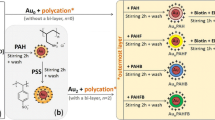Abstract
The pH-dependent binding affinity of either avidin or streptavidin for iminobiotin has been utilized in studies ranging from affinity binding chromatography to dynamic force spectroscopy. Regardless of which protein is used, the logarithmic dependence of the equilibrium dissociation constant (Kd) on pH is assumed conserved. However a discrepancy has emerged from a number of studies which have shown the binding affinity of streptavidin for iminobiotin in solution to be unexpectedly low, with the Kd at values usually associated with non-specific binding even at strongly basic pH levels. In this work we have utilized a Bodipy fluorescent conjugate of avidin and an Oregon Green fluorescent conjugate of streptavidin to determine the Kd of the complexes in solution in the pH range of 7.0 to 10.7. The study was made possible by the remarkable fluorescent enhancement of the two fluorescent conjugates (greater than 10 fold) upon saturation with iminobiotin. The streptavidin-iminobiotin interaction exhibited almost no pH dependence over the range studied, with Kd consistently on the order of 10−5 M. In contrast, under identical experimental conditions the avidin-iminobiotin interaction exhibited the expected logarithmic dependence on pH. We discuss the possible origins for why these two closely related proteins would diverge in their binding affinities for iminobiotin as a function of pH.





Similar content being viewed by others
References
Green NM (1966) Thermodynamics of binding of biotin and some analogues by avidin. Biochem J 101:774–780
Heney G, Orr GA (1981) The purification of avidin and its derivatives on 2-iminobiotin-6-aminohexyl-sepharose 4B. Anal Biochem 114:92–96
Hofmann K, Titus G, Montibeller JA, Finn FM (1982) Avidin binding of carboxyl-substituted biotin and analogs. Biochemistry 21:978–984
Orr GA (1981) The use of the 2-iminobiotin-avidin interaction for the selective retrieval of labeled plasma-membrane components. J Biol Chem 256:761–766
von Leoprechting A, Horth P, Haehnel W, Schilz E, Muhlenhoff U (1998) Identification of biotinylation sites on proteins by selective retrieval of 2-iminobiotinylated peptides from proteolytic peptide mixtures: localization of the accessible lysine residues on the photosystem I subunits PsaD and PsaE. Anal Biochem 262:110–121
Zeheb R, Chang V, Orr GA (1983) An analytical method for the selective retrieval of iminobiotin-derivatized plasma-membrane proteins. Anal Biochem 129:156–161
Garret-Flaudy F, Freitag R (2001) Use of the avidin (imino)biotin system as a general approach to affinity precipitation. Biotechnol Bioeng 71:223–234
Cao Y, Bai G, Zhang L, Bai F, Yang WB (2006) Immobilized iminobiotin on magnetic poly(vinyl alcohol) microspheres for single-step purification of streptavidin. Artif Cells Blood Substit Biotechnol 34:487–500
Hofmann K, Wood SW, Brinton CC, Montibeller JA, Finn FM (1980) Imino-biotin affinity columns and their application to retrieval of streptavidin. Proc Nat Acad Sci USA 77:4666–4668
Hylarides MD, Mallett RW, Meyer DL (2001) A robust method for the preparation and purification of antibody/streptavidin conjugates. Bioconjug Chem 12:421–427
Melkko S, Dumelin CE, Scheuermann J, Neri D (2006) On the magnitude of the chelate effect for the recognition of proteins by pharmacophores scaffolded by self-assembling oligonucleotides. Chem Biol 13:225–231
Reznik GO, Vajda S, Sano T, Cantor CR (1998) A streptavidin mutant with altered ligand-binding specificity. Proc Nat Acad Sci USA 95:13525–13530
Alhakiem MHH, Landon J, Smith DS, Nargessi RD (1981) Fluorimetric assays for avidin and biotin based on biotin-induced fluorescence enhancement of the fluorescein-labeled avidin. Anal Biochem 116:264–267
Emans N, Biwersi J, Verkman AS (1995) Imaging of endosome fusion in BHK fibroblasts based on a novel fluorometric avidin-biotin binding assay. Biophys J 69:716–728
Athappilly FK, Hendrickson WA (1997) Crystallographic analysis of the pH-dependent binding of iminobiotin by streptavidin. Protein Sci 6:1338–1342
Schwartz BL, Gale DC, Smith RD, Chilkoti A, Stayton PS (1995) Investigation of noncovalent ligand-binding to the intact streptavidin tetramer by electrospray-ionization mass-spectrometry. J Mass Spectrom 30:1095–1102
Wortmann A, Jecklin MC, Touboul D, Badertscher M, Zenobi R (2008) Binding constant determination of high-affinity protein-ligand complexes by electrospray ionization mass spectrometry and ligand competition. J Mass Spectrom 43:600–608
Clarkson J, Batchelder DN, Smith DA (2001) UV resonance Raman study of streptavidin binding of biotin and 2-iminobiotin: comparison with avidin. Biopolymers 62:307–314
Miyamoto S, Kollman PA (1993) Absolute and relative binding free-energy calculations of the interaction of biotin and its analogs with streptavidin using molecular-dynamics free-energy perturbation approaches. Proteins Struct Funct Bioinform 16:226–245
Moy VT, Florin EL, Gaub HE (1994) Intermolecular forces and energies between ligands and receptors. Science 266:257–259
Green NM (1990) Avidin and Streptavidin. Meth Enzymol 184:51–67
Weber PC, Wendoloski JJ, Pantoliano MW, Salemme FR (1992) Crystallographic and thermodynamic comparison of natural and synthetic ligands bound to streptavidin. J Am Chem Soc 114:3197–3200
Florin EL, Moy VT, Gaub HE (1994) Adhesion forces between individual ligand-receptor pairs. Science 264:415–417
Merkel R, Nassoy P, Leung A, Ritchie K, Evans E (1999) Energy landscapes of receptor-ligand bonds explored with dynamic force spectroscopy. Nature 397:50–53
Zhang XH, Moy VT (2003) Cooperative adhesion of ligand-receptor bonds. Biophys Chem 104:271–278
Author information
Authors and Affiliations
Corresponding author
Rights and permissions
About this article
Cite this article
Raphael, M.P., Rappole, C.A., Kurihara, L.K. et al. Iminobiotin Binding Induces Large Fluorescent Enhancements in Avidin and Streptavidin Fluorescent Conjugates and Exhibits Diverging pH-Dependent Binding Affinities. J Fluoresc 21, 647–652 (2011). https://doi.org/10.1007/s10895-010-0752-8
Received:
Accepted:
Published:
Issue Date:
DOI: https://doi.org/10.1007/s10895-010-0752-8




